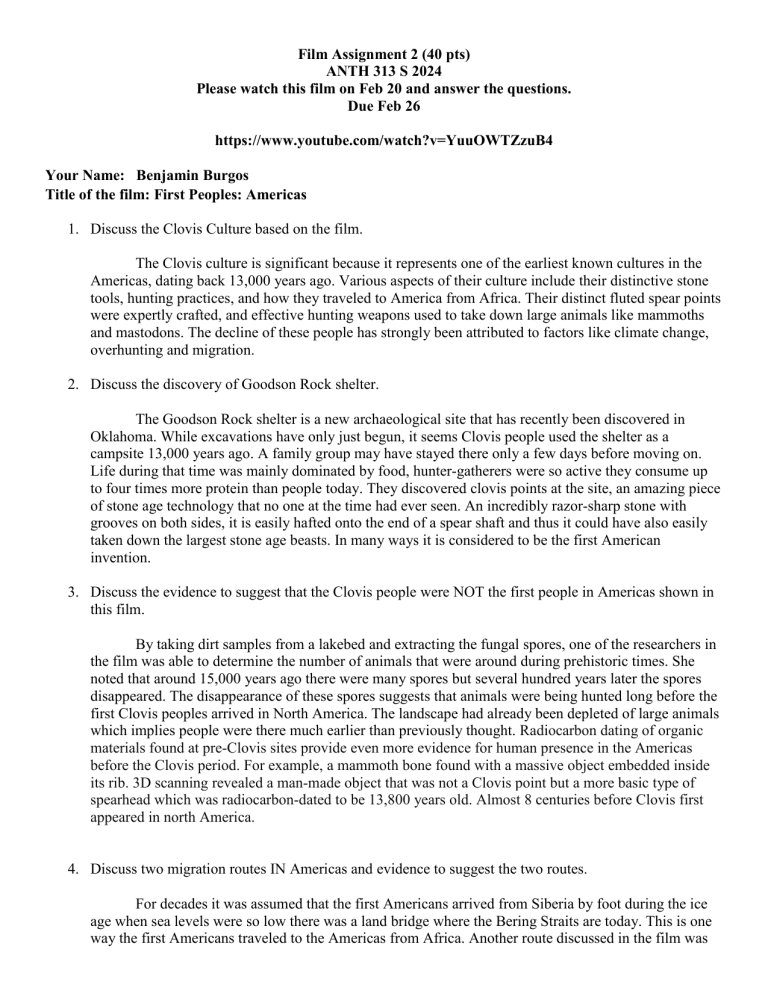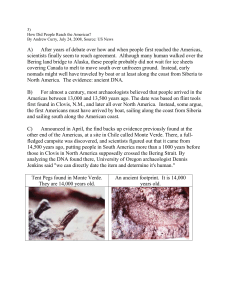
Film Assignment 2 (40 pts) ANTH 313 S 2024 Please watch this film on Feb 20 and answer the questions. Due Feb 26 https://www.youtube.com/watch?v=YuuOWTZzuB4 Your Name: Benjamin Burgos Title of the film: First Peoples: Americas 1. Discuss the Clovis Culture based on the film. The Clovis culture is significant because it represents one of the earliest known cultures in the Americas, dating back 13,000 years ago. Various aspects of their culture include their distinctive stone tools, hunting practices, and how they traveled to America from Africa. Their distinct fluted spear points were expertly crafted, and effective hunting weapons used to take down large animals like mammoths and mastodons. The decline of these people has strongly been attributed to factors like climate change, overhunting and migration. 2. Discuss the discovery of Goodson Rock shelter. The Goodson Rock shelter is a new archaeological site that has recently been discovered in Oklahoma. While excavations have only just begun, it seems Clovis people used the shelter as a campsite 13,000 years ago. A family group may have stayed there only a few days before moving on. Life during that time was mainly dominated by food, hunter-gatherers were so active they consume up to four times more protein than people today. They discovered clovis points at the site, an amazing piece of stone age technology that no one at the time had ever seen. An incredibly razor-sharp stone with grooves on both sides, it is easily hafted onto the end of a spear shaft and thus it could have also easily taken down the largest stone age beasts. In many ways it is considered to be the first American invention. 3. Discuss the evidence to suggest that the Clovis people were NOT the first people in Americas shown in this film. By taking dirt samples from a lakebed and extracting the fungal spores, one of the researchers in the film was able to determine the number of animals that were around during prehistoric times. She noted that around 15,000 years ago there were many spores but several hundred years later the spores disappeared. The disappearance of these spores suggests that animals were being hunted long before the first Clovis peoples arrived in North America. The landscape had already been depleted of large animals which implies people were there much earlier than previously thought. Radiocarbon dating of organic materials found at pre-Clovis sites provide even more evidence for human presence in the Americas before the Clovis period. For example, a mammoth bone found with a massive object embedded inside its rib. 3D scanning revealed a man-made object that was not a Clovis point but a more basic type of spearhead which was radiocarbon-dated to be 13,800 years old. Almost 8 centuries before Clovis first appeared in north America. 4. Discuss two migration routes IN Americas and evidence to suggest the two routes. For decades it was assumed that the first Americans arrived from Siberia by foot during the ice age when sea levels were so low there was a land bridge where the Bering Straits are today. This is one way the first Americans traveled to the Americas from Africa. Another route discussed in the film was by boat. While the land at the time was still blocked by ice, the coast of the Pacific Northwest was mostly ice-free. Making it possible for the first Americans to find a route south, bypassing any icebergs and living from the bounty of the sea. The film suggests they could have paddled down the kelp highway along the Pacific coast from North to South America, all the way to Patagonia. 5. How closely related were these early Americans shown in this film to today's Native Americans? How to explain the difference between the early Americans and modern-day Native Americans? Researchers like Doug Owsley believed that there was no ancestral link between modern-day Native Americans and the Kennewick man, the oldest human remains found in America. He asserted native Americans have a distinctly different shape to their skulls and facial structures. Stating the Native Americans have very broad cheeks and a short cranium. He also states the skulls of the Kennewick man more closely resemble the Polynesian-looking people known as the Inu. They are traditional huntergatherers from northern Japan who shared similar profiles in their skull, which were long and narrow. Eska Willerslev, a pioneer in the field of ancient genomics managed to extract some DNA from the Kennewick man, and after sequencing parts of the genome ultimately proved that the ancient man is closer related to contemporary Native Americans than any other peoples in the world.

